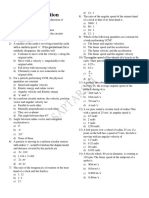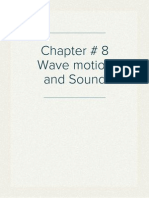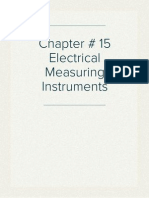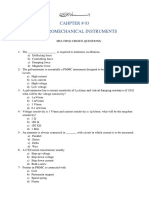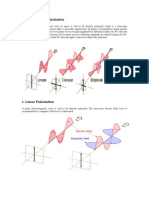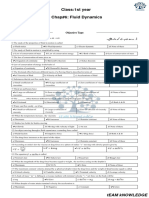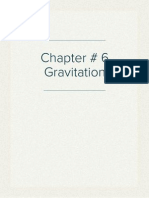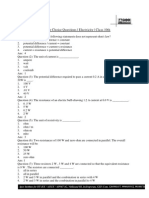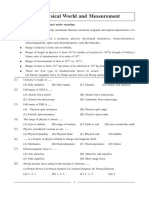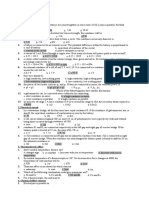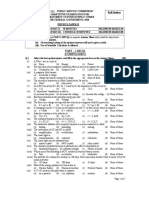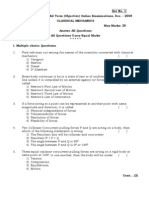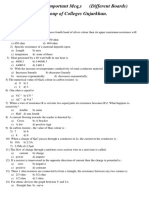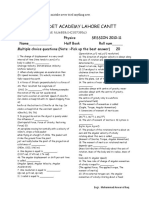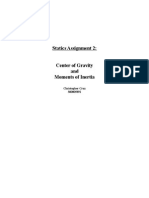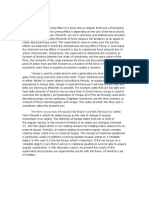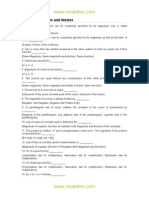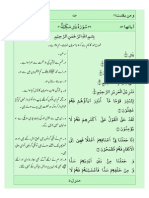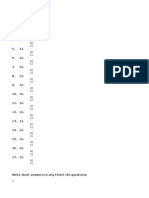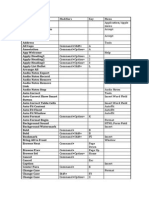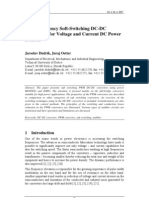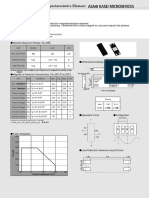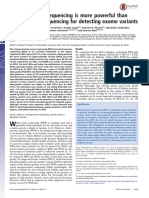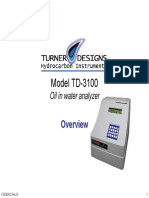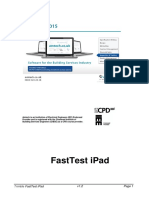70%(10)70% found this document useful (10 votes)
3K viewsTorque and Equilibrium Mcqs
Torque and Equilibrium Mcqs
Uploaded by
Faraz AhmadThe document contains 20 multiple choice questions about torque and equilibrium. Some key points covered are:
1. Torque is defined as the time rate of change of angular momentum.
2. The direction of torque is opposite to the direction of the applied force.
3. In rotational motion, the analog of force is torque.
4. The magnitude of torque is equal to the product of the force and the moment arm, which is the perpendicular distance between the point of rotation and the line of action of the force.
5. For a body to be in equilibrium, the vector sum of all forces and torques acting on it must be zero.
Copyright:
© All Rights Reserved
Available Formats
Download as DOCX, PDF, TXT or read online from Scribd
Torque and Equilibrium Mcqs
Torque and Equilibrium Mcqs
Uploaded by
Faraz Ahmad70%(10)70% found this document useful (10 votes)
3K views2 pagesThe document contains 20 multiple choice questions about torque and equilibrium. Some key points covered are:
1. Torque is defined as the time rate of change of angular momentum.
2. The direction of torque is opposite to the direction of the applied force.
3. In rotational motion, the analog of force is torque.
4. The magnitude of torque is equal to the product of the force and the moment arm, which is the perpendicular distance between the point of rotation and the line of action of the force.
5. For a body to be in equilibrium, the vector sum of all forces and torques acting on it must be zero.
Original Description:
Basic MCQ questions for intermediate students
Copyright
© © All Rights Reserved
Available Formats
DOCX, PDF, TXT or read online from Scribd
Share this document
Did you find this document useful?
Is this content inappropriate?
The document contains 20 multiple choice questions about torque and equilibrium. Some key points covered are:
1. Torque is defined as the time rate of change of angular momentum.
2. The direction of torque is opposite to the direction of the applied force.
3. In rotational motion, the analog of force is torque.
4. The magnitude of torque is equal to the product of the force and the moment arm, which is the perpendicular distance between the point of rotation and the line of action of the force.
5. For a body to be in equilibrium, the vector sum of all forces and torques acting on it must be zero.
Copyright:
© All Rights Reserved
Available Formats
Download as DOCX, PDF, TXT or read online from Scribd
Download as docx, pdf, or txt
70%(10)70% found this document useful (10 votes)
3K views2 pagesTorque and Equilibrium Mcqs
Torque and Equilibrium Mcqs
Uploaded by
Faraz AhmadThe document contains 20 multiple choice questions about torque and equilibrium. Some key points covered are:
1. Torque is defined as the time rate of change of angular momentum.
2. The direction of torque is opposite to the direction of the applied force.
3. In rotational motion, the analog of force is torque.
4. The magnitude of torque is equal to the product of the force and the moment arm, which is the perpendicular distance between the point of rotation and the line of action of the force.
5. For a body to be in equilibrium, the vector sum of all forces and torques acting on it must be zero.
Copyright:
© All Rights Reserved
Available Formats
Download as DOCX, PDF, TXT or read online from Scribd
Download as docx, pdf, or txt
You are on page 1of 2
MCQs on Torque and Equilibrium
1. Torque is defined as __________.
(Time rate of change of angular momentum, Time rate of change of linear momentum, time rate
of change of angular velocity)
2. The vector quantity torque __________.
(Depends on the choice of origin, does not depend on the choice of origin)
3. The direction of torque is __________.
(The same as the direction of the corresponding applied force, opposite to the direction of the
applied force, perpendicular to the direction of applied force)
4. The physical quantity, which produces angular acceleration, is called __________.
(Centripetal Force, Torque, Angular Velocity)
5. In rotational motion, the analog of force is __________.
(rotational inertia, moment of inertia, torque)
6. The term torque is synonymous with __________.
(Moment of force, Moment of inertia, Angular Momentum)
7. The product of force times the perpendicular distance between some point and the line of
action of the force is __________.
(the moment of inertia acting on the body, The moment of force about the chosen point, The
angular momentum of the body)
8. The magnitude of torque is equal to the product of the force and the moment arm. The moment
arm is __________.
(The distance between the point (point chosen), and the point of action of the force, the
maximum distance between the point and the line of action of the force, The minimum
(perpendicular) distance between the pivot and the line of action of the force)
9. If the direction of the applied force is reversed then __________.
(Its torque remains unchanged, the magnitude of its torque changes and direction of the torque
remains the same, The magnitude of its torque remains the same but the direction of the torque
reverses)
10. The time rate of change of angular momentum of a body is equal to __________.
(The applied force, The applied torque, The moment of inertia)
11. If no external torques act, the angular momentum of a body rotating about a fixed axis in two
dimension is __________.
(Variable, Constant, Not conserved)
12. The turning effect of a force is called __________.
(Acceleration, Torque, Velocity)
13. If is the angle between force and displacement vectors then the physical quantity torque is
mathematically expressed as __________.
( = rFsin, = Frcos, = Frtan)
14. The perpendicular distance from the axis of rotation of a body to the line of action of a force
is called __________.
(Moment Arm, Torque, Displacement)
15. If the moment arm of a force is zero, i.e. the line of action of a force is passing through the
pivot then the magnitude of the torque generated as such is __________.
(Zero, Clockwise, Anticlockwise)
16. The torque depends upon __________.
(Magnitude of force, Magnitude of Displacement, Magnitude of Force and Displacement)
17. The magnitude of torque will be zero if the angle between force and displacement is
__________.
(0, 45, 60)
18. The condition for equilibrium of a particle is that the __________.
(Vector sum of all forces be zero, Acceleration be constant, Vector sum of the forces and torques
be zero)
19. The particle moving with constant velocity may be __________.
(Changing in direction, Acceleration, In equilibrium)
20. It is easier to turn a steering wheel with both hands than with a single hand because
__________.
(A couple acts on the wheel, Two equal and opposite forces act on the wheel, The wheel is more
strongly gripped)
You might also like
- Physics Question Bank PDFDocument209 pagesPhysics Question Bank PDFAnivia1250% (2)
- Circular Motion MCQ PDFDocument13 pagesCircular Motion MCQ PDFGiriprasad Gunalan100% (3)
- SOP Service Apartment OperatorDocument4 pagesSOP Service Apartment OperatoradibazinunNo ratings yet
- Chapter # 5: Circular Motion: Physics (MCQ'S) 1 YearDocument3 pagesChapter # 5: Circular Motion: Physics (MCQ'S) 1 YearBilal Jamil0% (1)
- MCQs Chap 2Document3 pagesMCQs Chap 2Sharjeel Pervaiz100% (1)
- Chapter # 05 Torque, Angular Momentum, and EquilibriumDocument10 pagesChapter # 05 Torque, Angular Momentum, and EquilibriumSIR USMAN KHAN100% (5)
- Chapter 7 Mcqs OscillationsDocument5 pagesChapter 7 Mcqs Oscillationsleen prasla100% (2)
- Heat 200 McqsDocument41 pagesHeat 200 McqsParshantKumarBajaj100% (2)
- Unit II MCQ Electricity, Magnetism and SemiconductorDocument14 pagesUnit II MCQ Electricity, Magnetism and SemiconductorUmesh PatilNo ratings yet
- The Educators, Sir Syed Campus, Pattoki: Round #Document7 pagesThe Educators, Sir Syed Campus, Pattoki: Round #Hamza TECHNo ratings yet
- Chapter # 8 Wave Motion and SoundDocument8 pagesChapter # 8 Wave Motion and SoundSIR USMAN KHAN86% (7)
- EMW QuizDocument7 pagesEMW QuizNaresh Kumar100% (4)
- Circular Motion MCQ PDFDocument17 pagesCircular Motion MCQ PDFZIA UR REHMANNo ratings yet
- Quantum Mechanics MCqsDocument19 pagesQuantum Mechanics MCqsalmasbashir001No ratings yet
- Mcqs With Answers Waves and OscillationDocument18 pagesMcqs With Answers Waves and OscillationGovt.GraduateCollege TobaTekSingh100% (2)
- Physics Wave Optics MCQDocument3 pagesPhysics Wave Optics MCQManjunath Sripathy100% (4)
- Engineering Mechanics MCQs PDFDocument22 pagesEngineering Mechanics MCQs PDFvimalNo ratings yet
- Chapter # 15 Electrical Measuring InstrumentsDocument5 pagesChapter # 15 Electrical Measuring InstrumentsSIR USMAN KHAN50% (2)
- Spacial Relativity McqsDocument14 pagesSpacial Relativity McqsMuhammad Noman Hameed100% (1)
- Physics Mcqs For Class 10thDocument16 pagesPhysics Mcqs For Class 10thharis khalidNo ratings yet
- Oscillation MCQDocument7 pagesOscillation MCQUmer KhalidNo ratings yet
- MCQSDocument14 pagesMCQSqasimNo ratings yet
- +2 PHYSICS 200 MCQ EM Test WITH Answer Key and Problems Key PDFDocument25 pages+2 PHYSICS 200 MCQ EM Test WITH Answer Key and Problems Key PDFRAJA100% (1)
- Laser Physics McqsDocument8 pagesLaser Physics McqsTalha Farooq0% (1)
- Physics XII The Nuclear Physics MCQDocument12 pagesPhysics XII The Nuclear Physics MCQSyed Mairaj Ul Haq74% (19)
- KinematicsDocument6 pagesKinematicsprem kumarNo ratings yet
- Electromagnetism McqsDocument2 pagesElectromagnetism McqsymeghnaNo ratings yet
- Classification of PolarizationDocument2 pagesClassification of Polarizationather_88No ratings yet
- Solved Chap 6 1st Year Physics MCQsDocument3 pagesSolved Chap 6 1st Year Physics MCQsAmna ShakeelNo ratings yet
- Gravitation MCQ TestDocument2 pagesGravitation MCQ TestrhythmNo ratings yet
- Thermodynamics MCQ PDFDocument9 pagesThermodynamics MCQ PDFNaveen RaiNo ratings yet
- Eletrical McqsDocument7 pagesEletrical McqsPravin Hande100% (1)
- Chapter 11 Mcq'sDocument28 pagesChapter 11 Mcq'sTahira JiNo ratings yet
- Quiz 2, Chapter 3-5Document7 pagesQuiz 2, Chapter 3-5Mansoor AslamNo ratings yet
- Statistical Mechanics Work Sheet 12Document8 pagesStatistical Mechanics Work Sheet 12davididosa40No ratings yet
- Chapter #06 GravitationDocument13 pagesChapter #06 GravitationSIR USMAN KHANNo ratings yet
- Electric Current MCQDocument5 pagesElectric Current MCQApex Institute100% (1)
- 11th MCQ Question BankDocument226 pages11th MCQ Question BankMiten Gandhi100% (1)
- Solved Chap 4 1st Year Physics MCQsDocument4 pagesSolved Chap 4 1st Year Physics MCQsAmna Shakeel100% (1)
- MCQ For XIIDocument23 pagesMCQ For XIIJaya MaharjanNo ratings yet
- Current ElectricityDocument337 pagesCurrent ElectricityAbdul RehmanNo ratings yet
- MCQs General Unit IDocument25 pagesMCQs General Unit IN1234m100% (1)
- Physics McqsDocument2 pagesPhysics McqsRajaRashidMahmoodSatti100% (1)
- XII Physics MCQS With KeyDocument38 pagesXII Physics MCQS With Keyfateen100% (1)
- One Mark Computational Fluid DynamicsDocument12 pagesOne Mark Computational Fluid Dynamicssivak1575No ratings yet
- Gravitation NotesDocument21 pagesGravitation NotesNuan Ting NgNo ratings yet
- Full Book MCQ 2ND Year With Answer KeyDocument5 pagesFull Book MCQ 2ND Year With Answer KeyAdnanNo ratings yet
- Vectors MCQDocument1 pageVectors MCQashrafrazi100% (7)
- Solid State Physics McqsDocument51 pagesSolid State Physics McqsZahid ur RehmanNo ratings yet
- MULTIPLE CHOICE QUIZ Total Internal ReflectionDocument1 pageMULTIPLE CHOICE QUIZ Total Internal ReflectionsurabhiNo ratings yet
- AP Phys C Fall Final Web RevDocument12 pagesAP Phys C Fall Final Web RevNadhya FadlillahNo ratings yet
- MCQS CH #3 - 1234Document7 pagesMCQS CH #3 - 1234Faisal IqbalNo ratings yet
- Unit-4 MCQDocument3 pagesUnit-4 MCQKushal BhattNo ratings yet
- 07A1EC03 - Classical MechanicsDocument12 pages07A1EC03 - Classical Mechanicsnakkantis80% (5)
- MCQ, S Current ElectricityDocument4 pagesMCQ, S Current Electricitybilal5202050No ratings yet
- McqsDocument15 pagesMcqsPriyansu Singh100% (2)
- Garrison Cadet Academy Lahore Cantt: Albert EinsteinDocument3 pagesGarrison Cadet Academy Lahore Cantt: Albert EinsteinEngr Anwaar JuttNo ratings yet
- Statics Assignment 2 PDFDocument7 pagesStatics Assignment 2 PDFDaniel RiddleNo ratings yet
- Grade 10 - Chapter 1 - Must Do PQ'sDocument19 pagesGrade 10 - Chapter 1 - Must Do PQ'syamunashetty5No ratings yet
- Torque: The Term Was Introduced Into English Scientific Literature byDocument2 pagesTorque: The Term Was Introduced Into English Scientific Literature byMd IjazNo ratings yet
- 300 MCQsDocument10 pages300 MCQsKatherine ThompsonNo ratings yet
- TimeTable UET Lahore - Spring 2017Document2 pagesTimeTable UET Lahore - Spring 2017Faraz AhmadNo ratings yet
- Surah YaseenDocument12 pagesSurah YaseenFaraz AhmadNo ratings yet
- A) C) A) C) A) C) A) C) A) C) A) C) A) C) A) C) A) C) A) C) A) C) A) C) A) C) A) C) A) C) A) C) A) C)Document2 pagesA) C) A) C) A) C) A) C) A) C) A) C) A) C) A) C) A) C) A) C) A) C) A) C) A) C) A) C) A) C) A) C) A) C)Faraz AhmadNo ratings yet
- MS Word CommandsDocument11 pagesMS Word CommandsFaraz AhmadNo ratings yet
- Beng Elec Spec 2013Document18 pagesBeng Elec Spec 2013Faraz AhmadNo ratings yet
- High-Frequency Soft-Switching DC-DC Converters For Voltage and Current DC Power SourcesDocument18 pagesHigh-Frequency Soft-Switching DC-DC Converters For Voltage and Current DC Power SourcesFaraz AhmadNo ratings yet
- Japitana HabitatSuitabilityModellingDocument16 pagesJapitana HabitatSuitabilityModellingprofni2001No ratings yet
- Front Back Inside Right Inside Left: X5340-0920 Angry Birds 1L InstructionsDocument1 pageFront Back Inside Right Inside Left: X5340-0920 Angry Birds 1L Instructionsalex gonzalezNo ratings yet
- Insb Semiconductor Magnetoresistive Element: Shipped in Tray (225Pcs Per Pack)Document3 pagesInsb Semiconductor Magnetoresistive Element: Shipped in Tray (225Pcs Per Pack)Umar MahmudNo ratings yet
- Forward Look 2023 - Analysis and Research TeamDocument19 pagesForward Look 2023 - Analysis and Research TeamRoel PlmrsNo ratings yet
- Cement - Mortar: Vicatronic Automatic Computerised Tropicalized Vicat Recording ApparatusDocument4 pagesCement - Mortar: Vicatronic Automatic Computerised Tropicalized Vicat Recording ApparatusLESO IndustrialNo ratings yet
- 2005 Pearson Education South Asia Pte LTDDocument68 pages2005 Pearson Education South Asia Pte LTDDickson LeongNo ratings yet
- Ug136 Ble C Soc Dev GuideDocument35 pagesUg136 Ble C Soc Dev GuideVenkat KrishnanNo ratings yet
- AP Bio Lab 3 FinalDocument6 pagesAP Bio Lab 3 Finalniteeshsettypalli100% (1)
- Whole Genome Sequencing Is More PowerfulDocument6 pagesWhole Genome Sequencing Is More PowerfulluismoralesmNo ratings yet
- Dovpo Topside Dual User ManualDocument1 pageDovpo Topside Dual User ManualTeoNo ratings yet
- Norbert Wiener - Men, Machines, and The World AboutDocument6 pagesNorbert Wiener - Men, Machines, and The World AboutBenjamim GomesNo ratings yet
- 03 1 TD3100 Manual TraningDocument38 pages03 1 TD3100 Manual TraningPhit Nguyen Viet100% (1)
- IGMO Round 2 1Document3 pagesIGMO Round 2 1Gabriel GohNo ratings yet
- Roth 1997 - Videodrome and The Revenge of RepresentationDocument7 pagesRoth 1997 - Videodrome and The Revenge of RepresentationAnonymous YPGZL5Q9dKNo ratings yet
- Pineapple WineDocument17 pagesPineapple WineBea Irish LubaoNo ratings yet
- Chapter 2. Lateral Earth PressureDocument31 pagesChapter 2. Lateral Earth PressureAndreea CălinNo ratings yet
- Grey's Anatomy TV Series, Season 1 - Teacher Sheila FariasDocument28 pagesGrey's Anatomy TV Series, Season 1 - Teacher Sheila FariasEmilly RafaelaNo ratings yet
- Quick Facts: Omnivore 5 To 9 Years 7.5 - 13 CM 2 - 20 Grams Diet: Life Span: Size: WeightDocument2 pagesQuick Facts: Omnivore 5 To 9 Years 7.5 - 13 CM 2 - 20 Grams Diet: Life Span: Size: WeightAlaNo ratings yet
- Custom Trays: Individualized Trays For Making Final Impressions Made On A Diagnostic CastDocument25 pagesCustom Trays: Individualized Trays For Making Final Impressions Made On A Diagnostic Castparee1No ratings yet
- EU RoHS Declaration Template English 2021Document4 pagesEU RoHS Declaration Template English 2021Ivan LugasanNo ratings yet
- Lost - Varian KrylovDocument80 pagesLost - Varian Krylovgleycesilva58tNo ratings yet
- P5 SST PDFDocument8 pagesP5 SST PDFkyalwazi kenneth shepherdNo ratings yet
- Hooke's LawDocument5 pagesHooke's LawDanelle EsparteroNo ratings yet
- Mobility and ImmobilityDocument40 pagesMobility and ImmobilityBabita DhruwNo ratings yet
- 30MW TG DatasheetDocument3 pages30MW TG Datasheetmeenakshisundaram100% (1)
- Myology: The Buccinators Mechanism The TongueDocument33 pagesMyology: The Buccinators Mechanism The TongueJee Arceo100% (1)
- Igorots: The People of The MountainsDocument7 pagesIgorots: The People of The MountainsMyrelle Da Jose SarioNo ratings yet
- Trimble Fasttest Ipad V1.2Document26 pagesTrimble Fasttest Ipad V1.2mohsin shaikhNo ratings yet
- Eulers Eqn and Pelton Wheel DesignDocument26 pagesEulers Eqn and Pelton Wheel DesignASHITA K BNo ratings yet

